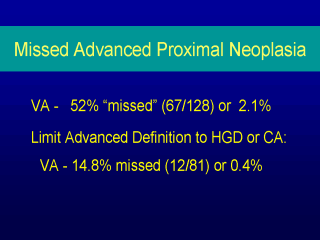 |
They made a guesstimate, an
arbitrary demarcation to say how many would be missed if those patients had just a
sigmoidoscopy. They found about 1-2% of people with advanced proximal neoplasia would be
missed if they came to screening and had a flexible sigmoidoscopy. Thatís what drives
the notion that everybody should have a colonoscopy and not a sigmoidoscopy. Older age is
at risk probably because as we age there is a greater likelihood for the proximal colon to
develop problems, and men seem to be at higher risk in these studies. Iíve played with
their definition of advanced, and if I only look at high grade dysplasia and cancer, in
fact only 15% of the advanced adenomas would be missed or only 0.4% overall in the
population. It starts to become a much smaller number. Then you have to be concerned about
the risks of the colonoscopy, which is .32% with major morbidity at 30 days. Itís not
absolute here that everybody should have a colonoscopy, or at least, one has to be
cognizant of some of the limitations. |
